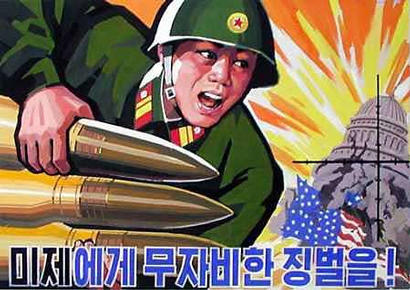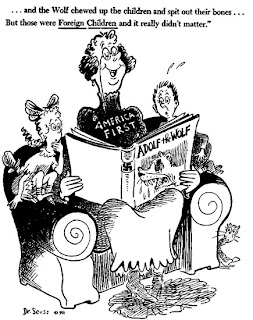The Causes of The Korean war
Causes
After World War Two, Korea was occupied by Japanese soldiers, who relinquished their land to the Allies. Korean land was distributed between the Soviets, the United States, France, and Britain. The Soviet Union wanted to claim Korea but The U.N. wasn't comfortable with having all that land be communist. They agreed that the North will be controlled by the Soviet Union and cut off at the 38th parallel. The southern part of Korea will be under U.N. control. in 1948 Soviet Russia declared that North Korea will be under communist control, and the 38th parallel would be a political border between the Communist North and the American South. The Northern communist dictator was Kim Il Sung, and the Southern dictator was Syngman Rhee, both wanted the others land. over 10,000 Korean soldiers on both sides died before the war started. The war officially began on June 28th, 1950 when North Korean troops passed the 38th parallel and invaded South Korea. |
| Most of the terrain was uphill during the Korean war. It added difficulty to what already seemed to be a struggle. That with the extreme temperatures, most soldiers were unprepared for the harshness of Korean land. |
 |
| Street battle in the town of Seoul. Civilian casualties were common during attacks. Most buildings were destroyed as a result of the battles. |
U.S. Involvement
Soon after the North invaded the South, Truman deployed troops in South Korea along with the UN (which were mostly American troops also). Douglas McArthur was the general for American troops and planned tricky and dangerous tactics but eventually pushed the North back. With the help of the Chinese, The U.S. troops were pushed back behind the 38th parallel and farther down south. With a strong counter attack UN and American troops fought back and brought both sides back to the 38th parallel where the war started in the first place. Eventually both sides called a truce and stayed behind their respective boundaries.
 |
| Picture of U.S. troops powering through the freezing weather conditions in Korea. The temperature was around 0 degrees Fahrenheit. Many troops suffered from frostbite. |
 |
| American troops crossing over the 28th parallel into North Korea. It is also known as the DMZ today. It is the line that was made after the truce that divides North and South. |
Setting
After World War II Korea, which was previously under Japanese control, was divided up between the U.S. and The Soviet Union. With the North being under communist control and the South being influenced heavily by the U.S. Tensions quickly rose and by the time the war was over 55,000 American troops lost their lives, while over 1 million North Korean and Chinese perished. Soldiers who fought in Korea dealt with extreme climates that were so cold that many suffered from frostbite. Soldiers weapons would freeze and be disabled due to the harsh weather. Korea has mountainous terrain which heavily affected the way the war was fought. The humid and scorching summers were breeding grounds for disease and infested with rats. |
| One of the toughest obstacles soldiers faced was the temperatures. Many troops froze to death as seen in this picture. With temperatures far below freezing, many of their rations would also freeze and be useless. |
 |
| American General, Douglas MacArthur sits comfortably alongside comrades. He got involved with politics believing that they should attack the Chinese at the source. Truman opposed his strategies believing that it would only make matters worse. |
 |
North Korean terrain was very mountainous. With large slopes it was very difficult to make it up hills while being fired at. Many American vehicles and weapons malfunctioned due to the climate.Home Front
The home front during the Korean War was completely different than WWII. During World War II many Americans rationed and sacrificed necessities for the troops over seas. During the Korean war many did not acknowledge a war was happening or did not care enough to do anything about it. Since the war in Korea happened so quickly after WWII ended many veterans did not want to sacrifice anymore. Truman did not even call it a war, but the "Korean Conflict". Congress never allowed Truman to go to war with North Korea but he was allowed to place troops there for defense. Those who did follow the war did not know the point or significance of it. There were not many radio broadcasts about how the war was going or propaganda posters encouraging the American public to ration food or cut down on gas.

One of the Korean propaganda posters showing a Korean soldiers bombing the White House. Support was much stronger on the Korean home front, which differs from the American home front. Many did not care about the war and did not support it.
End
3 years later the U.S came to armistice with China and North Korea. The Korean War was one of the first outcomes of the cold war with Russia. Communism vs. Capitalism was the theme during the cold war and the U.S. was determined to contain it. The truce between the 3 nations left U.S. citizens and officials unsatisfied because we technically didn't "win". During the first year the United Nations and U.S. troops pushed Korean soldiers up North, and looked like a promising victory. However the newly communist leader in China sent troops in and fought back the U.N. and were pushed down south. With the agreement of a stalemate the nations came together and divided Korea into 2 sections, North and South. It was split at the 38th parallel, and named the DMZ (demilitarized zone). Both nations are still in high tension with the fact that communist North wants to invade capitalist, westernized South.
Many men dreaded being drafted for the Korean War. Bob Hughes, a Korean war vet, said," They took me screaming and hollering." The draft took many troops that wished they could refuse to go to war.
General Douglas MacArthur was the most well known generals to come from the Korean war because of his compassion towards the cause. "I would defend Korea as I would my own country-just as a I would California" (MacArthur). His passion led him to compete in a political race with Truman.
What made the war in the Korea so difficult was the unforgiving terrain. "On the other side of every mountain was another mountain" (George Russel). It was physically exhausting for troops to fight while traveling up hills.
Bob Hughes, who was a field medic during the Korea war remembers the constant stress of trying to heal wounded soldiers. "A guy ran to me screaming that he was shot in the arm, I told him it was impossible because his arm was shot clean off" (Hughes). Many wounded soldiers struggled to get the correct aid because they were under constant fire.
The Korean war was a nasty, unforgiving war on American troops. "If you came out and said you weren't lucky you had problems" (Hughes). He claims that anyone who survived the Korean war was lucky and should be happy they made it out alive.
|











